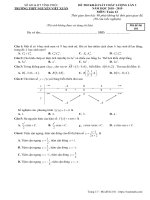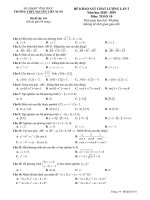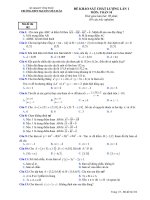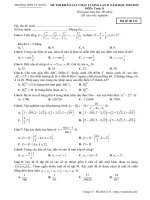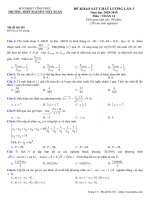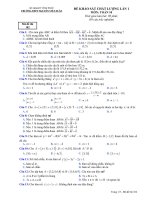Đề KSCL Tiếng Anh 11 lần 3 năm 2018 – 2019 trường Nguyễn Viết Xuân – Vĩnh Phúc - THI247.com
Bạn đang xem bản rút gọn của tài liệu. Xem và tải ngay bản đầy đủ của tài liệu tại đây (315.39 KB, 6 trang )
<span class='text_page_counter'>(1)</span><div class='page_container' data-page=1>
TRƯỜNG THPT NGUYỄN VIẾT XUÂN
( Đề thi có 4 trang)
<b>ĐỀ KSCL LẦN 3 NĂM HỌC 2018 - 2019 </b>
<b><sub>MÔN: TIẾNG ANH 11 </sub></b>
<i>Thời gian làm bài: 60 phút; (50 câu trắc nghiệm) </i>
<i>(Thí sinh khơng được sử dụng tài liệu)</i>
<b>Mã đề thi </b>
<b>101 </b>
Họ và tên:... Số báo danh: ...
<i><b>Mark the letter A, B, C, or D on your answer sheet to indicate the word(s) OPPOSITE in meaning to the </b></i>
<i><b>underlined word(s) in each of the following questions. </b></i>
<b>Câu 1: Drivers are advised to get enough petrol because filling stations are few and far between on the highway. </b>
<b>A. impossible to reach </b> <b>B. easy to find </b> <b>C. unlikely to happen </b> <b>D. difficult to access. </b>
<b>Câu 2: The aircraft carrier is indispensable in naval operations against sea or shore based enemies. </b>
<b>A. unnecessary </b> <b>B. unique </b> <b>C. novel </b> <b>D. exotic </b>
<i><b>Mark the letter A, B, C, or D on your answer sheet to indicate the word that differs from the other three in the </b></i>
<i><b>position of primary stress in each of the following questions from 1 to 2. </b></i>
<b>Câu 3: </b> <b>A. promise </b> <b>B. balance </b> <b>C. publish </b> <b>D. maintain </b>
<b>Câu 4: </b> <b>A. decorate </b> <b>B. demonstrate </b> <b>C. occasion </b> <b>D. company </b>
<i><b>Read the following passage and mark the letter A, B, C, or D on your answer sheet to indicate the word or </b></i>
<i><b>phrase that best fits each of the numbered blanks from 5 to 9. </b></i>
In England, Wales and Northern Ireland, higher education institutions are (5)_______, self-governing
bodies active in teaching, research and scholarship. They are established (6)_______ Royal Charter or legislation
and most are part-funded by government. Higher education is provided by many different types of institution.
Teaching to prepare students for the award of higher education qualifications can be conducted in any higher
education institution and in some (7)_______ education colleges.
All universities and many higher education colleges have the legal power to (8)_______ their own courses
and award their own degrees, as well as determine the conditions on which they are awarded. All institutions are
subject to the same regulatory quality assurance and funding requirements as universities; and all institutions
decide for themselves (9)_______ students to admit and which staff to appoint. Degrees and other higher education
qualifications are legally owned by the awarding institution, not by the state.
<b>Câu 5: </b> <b>A. independence </b> <b>B. dependent </b> <b>C. dependence </b> <b>D. independent </b>
<b>Câu 6: </b> <b>A. from </b> <b>B. in </b> <b>C. by </b> <b>D. for </b>
<b>Câu 7: </b> <b>A. far </b> <b>B. farther </b> <b>C. high </b> <b>D. further </b>
<b>Câu 8: </b> <b>A. develop </b> <b>B. produce </b> <b>C. discover </b> <b>D. do </b>
<b>Câu 9: </b> <b>A. who </b> <b>B. that </b> <b>C. whom </b> <b>D. which </b>
<i><b>Mark the letter A, B, C, or D on your answer sheet to indicate the underlined part that needs correction in each of </b></i>
<i><b>the following questions. </b></i>
<b>Câu 10: Some of the relics found at the archeological site of the Central Sector of the Imperal Citadel of Thang </b>
Long belongs to the Ly Dynasty.
<b>A. found </b> <b>B. belongs </b> <b>C. archeological </b> <b>D. of </b>
<b>Câu 11: Students who first language is not English need to take an English language test like IELTS. </b>
<b>A. who </b> <b>B. like </b> <b>C. to take </b> <b>D. is </b>
<b>Câu 12: The beautifully tall young girl standing over there is a new English teacher. </b>
<b>A. is </b> <b>B. standing </b> <b>C. beautifully </b> <b>D. new </b>
<i><b>Mark the letter A, B, C, or D on your answer sheet to indicate the correct answer to each of the following </b></i>
<i><b>questions. </b></i>
<b>Câu 13: Most of the citadel is _______ ruins. </b>
<b>A. of </b> <b>B. in </b> <b>C. on </b> <b>D. at </b>
<b>Câu 14: The government has come _______ a lot of criticism over the decision. </b>
</div>
<span class='text_page_counter'>(2)</span><div class='page_container' data-page=2>
Trang 2/4 - Mã đề thi 101 -
<b>Câu 15: The old man _______ next to me on the pier was muttering to himself. </b>
<b>A. fished </b> <b>B. who fishing </b> <b>C. was fishing </b> <b>D. fishing </b>
<b>Câu 16: Mr. Smith is ________ old customer and ________ honest man. </b>
<b>A. the/an </b> <b>B. an/an </b> <b>C. an/the </b> <b>D. the/the </b>
<b>Câu 17: Motor vehicles running on petrol are _______ for a large amount of carbon dioxide emissions. </b>
<b>A. responsibility </b> <b>B. responsibly </b> <b>C. responsible </b> <b>D. respond </b>
<b>Câu 18: The storm causing flooding and landslides in Miami prompted the government to _______ hundreds of </b>
people from coastal towns.
<b>A. evaporate </b> <b>B. contribute </b> <b>C. demolish </b> <b>D. evacuate </b>
<b>Câu 19: Only when I went abroad to study _______ that everything was not as easy as it seemed. </b>
<b>A. I did realize </b> <b>B. did I realize </b> <b>C. did I realized </b> <b>D. I realized </b>
<b>Câu 20: I think that my abilities, personality, and my experience will meet the _______ of the job. </b>
<b>A. qualifications </b> <b>B. satisfaction </b> <b>C. requirements </b> <b>D. information </b>
<b>Câu 21: Mary is still surfing the Internet. She _______ for information about further education in Singapore since </b>
last Monday.
<b>A. has researched </b> <b>B. is searching </b> <b>C. has been searching </b> <b>D. searched </b>
<b>Câu 22: If he had told me the truth, I _______ him. </b>
<b>A. would have punished </b> <b>B. would not punish </b>
<b>C. will not punish </b> <b>D. would not have punished </b>
<b>Câu 23: I can’t give my teacher the homework today because I _______ it. </b>
<b>A. haven’t finished </b> <b>B. haven’t been finishing </b>
<b>C. did not finish </b> <b>D. don’t finish </b>
<b>Câu 24: It seems that you are right, _______? </b>
<b>A. aren’t you </b> <b>B. are you </b> <b>C. doesn’t it </b> <b>D. does it </b>
<i><b>Mark the letter A, B, C, or D on your answer sheet to indicate the most suitable response to complete each of </b></i>
<i><b>the following exchanges. </b></i>
<b>Câu 25: - Tom: “ Why don’t we visit the royal tomb?” – David: “_______.” </b>
<b>A. Thank you. It’s really encouraging </b> <b>B. It sounds great </b>
<b>C. Sorry, I haven’t got it </b> <b>D. It’s very kind of you </b>
<b>Câu 26: Mary: “ Would you like some tea or coffee?” </b> - Susan: “_______”
<b>A. Yes, I like. </b> <b>B. Thank you </b> <b>C. Coffee, please. </b> <b>D. Yes, I would. </b>
<i><b>Mark the letter A, B, C, or D on your answer sheet to indicate the word(s) CLOSEST in meaning to the </b></i>
<i><b>underlined word(s) in each of the following questions. </b></i>
<b>Câu 27: The burglar crept into the house without making any noise. That’s why no one heard anything. </b>
<b>A. rapidly </b> <b>B. silently </b> <b>C. carefully </b> <b>D. slowly </b>
<b>Câu 28: The maintenance of these old castles must cost a lot of money. </b>
<b>A. preservation </b> <b>B. foundation </b> <b>C. building </b> <b>D. destruction </b>
<i><b>Mark the letter A, B, C, or D on your answer sheet to indicate the sentence that is </b><b>CLOSEST in meaning to </b></i>
<i><b>each of the following questions. </b></i>
<b>Câu 29: He said, “I’m sorry I didn’t reply to the letter.” </b>
<b>A. He apologized for not replying to the letter. </b> <b>B. He apologized for not to replying to the letter. </b>
<b>C. He apologized for not to reply to the letter. </b> <b>D. He apologized for didn’t reply to the letter. </b>
<b>Câu 30: It is said that she has met her mother several times. </b>
<b>A. It is said that her mother has been met several times. B. She is said to have met her mother several times. </b>
<b>C. She is said that her mother has been met several times. D. People said that her mother has met several times. </b>
<b>Câu 31: Because he had spent all day yesterday hanging out with his friends, he needed to stay awake all night to </b>
meet the deadline.
<b>A. Having been spent all day yesterday hanging out with his friends, he needed to stay awake all night to meet </b>
the deadline.
<b>B. Before spending all day yesterday hanging out with his friends, he needed to stay awake all night to meet the </b>
deadline.
</div>
<span class='text_page_counter'>(3)</span><div class='page_container' data-page=3>
<b>D. After staying awake all night to meet the deadline, he spent all day yesterday hanging out with his friends. </b>
<i><b>Mark the letter A, B, C, or D on your answer sheet to indicate the word whose underlined part differs from the </b></i>
<i><b>other three in pronunciation in each of the following questions. </b></i>
<b>Câu 32: A. though </b> <b>B. rough </b> <b>C. laugh </b> <b>D. tough </b>
<b>Câu 33: A. primary </b> <b>B. divide </b> <b>C. science </b> <b>D. examine </b>
<i><b>Mark the letter A, B, C, or D on your answer sheet to indicate the sentence that best combines each pair of </b></i>
<i><b>sentences in the following questions. </b></i>
<b>Câu 34: David had taken an active part in the Green Summer activities. He was rewarded for that. </b>
<b>A. David took an active part in Summer activities, he awarded for it. </b>
<b>B. After taken an active part in the Summer activities, David was awarded. </b>
<b>C. Having been taken an active part in the Summer activities, David was awarded. </b>
<b>D. David was rewarded for having taken an active part in the Summer activities. </b>
<b>Câu 35: You’d better write the date on your calendar. You might forget about the exam. </b>
<b>A. You might forget about the exam, so you’d better write the date on your calendar. </b>
<b>B. You’d better write the date on your calendar if you might forget about the exam. </b>
<b>C. You might forget about the exam although you’d better write the date on your calendar. </b>
<b>D. You’d better write the date on your calendar, so you might forget about the exam. </b>
<i><b>Read the following passage and mark the letter A, B, C, or D on your answer sheet to indicate the correct </b></i>
<i><b>answer to each of the questions from 36 to 43. </b></i>
Let children learn to judge their own work. A child learning to talk does not learn by being corrected all the
time. If corrected too much, he will stop talking. He notices a thousand times a day the difference between the
language he uses and the language those around him use. Bit by bit, he makes the necessary changes to make his
language like other people’s. In the same way, children learn all the other things they learn to do without being
taught – to talk, run, climb, whistle, ride a bicycle – compare their own performances with <b>those of more skilled </b>
people, and slowly make the needed changes. But in school we never give a child a chance to find out his mistakes
for himself, let alone correct them. We do it all for him. We act as if we thought that he would never notice a
mistake unless it was pointed out to him, or correct it unless he was made to. Soon he becomes dependent on the
teacher. Let him do it himself. Let him work out, with the help of other children if he wants it, what this word says,
what the answer is to that problem, whether this is a good way of saying or doing this or not.
If it is a matter of right answers, as it may be in mathematics or science, give him the answer book. Let him
correct his own papers. Why should we teachers waste time on such routine work? Our job should be to help the
child when he tells us that he can’t find the way to get the right answer. Let’s end all this nonsense of grades,
exams, and marks. Let us throw them all out, and let the children learn what all educated persons must someday
learn, how to measure their own understanding, how to know what they know or do not know.
Let them get on with this job in the way that seems most sensible to them, with our help as school teachers
if they ask for it. The idea that there is a body of knowledge to be learnt at school and used for the rest of one’s life
is nonsense in a world as <b>complicated and rapidly changing as ours. Anxious parents and teachers say, “But </b>
suppose they fail to learn something essential, something they will need to get on in the world?” Don’t worry! If it
is essential, they will go out into the world and learn it.
<b>Câu 36: What does the author think is the best way for children to learn things? </b>
<b>A. By making mistakes and having them corrected. B. By copying what other people do. </b>
<b>C. By listening to explanations from skilled people. D. By asking a great many questions. </b>
<b>Câu 37: The passage suggests that learning to speak and learning to ride a bicycle are _______. </b>
<b>A. basically different from learning adult skills </b> <b>B. more important than other skills </b>
<b>C. not really important skills </b> <b>D. basically the same as learning other skills </b>
<b>Câu 38: What does the author think teachers do which they should not do? </b>
<b>A. They encourage children to copy from one another B. They allow children to mark their own work </b>
<b>C. They give children correct answers </b> <b>D. They point out children’s mistakes to them </b>
<b>Câu 39: The word “those” in the first paragraph refers to _______. </b>
<b>A. things </b> <b>B. skills </b> <b>C. performances </b> <b>D. changes </b>
<b>Câu 40: According to the first paragraph, what basic skills do children learn to do without being taught? </b>
<b>A. Running, walking and playing </b> <b>B. Talking, climbing and whistling </b>
<b>C. Reading, talking and hearing </b> <b>D. Talking, running and skiing </b>
</div>
<span class='text_page_counter'>(4)</span><div class='page_container' data-page=4>
Trang 4/4 - Mã đề thi 101 -
<b>A. educated persons </b> <b>B. teachers </b>
<b>C. parents </b> <b>D. the children themselves </b>
<b>Câu 42: The word “complicated” in the third paragraph is closest in meaning to _______. </b>
<b>A. compliment </b> <b>B. complex </b> <b>C. competitive </b> <b>D. comfortable </b>
<b>Câu 43: The author fears that children will grow up into adults who are _______. </b>
<b>A. unable to think for themselves </b> <b>B. unable to use basic skills </b>
<b>C. too independent of others </b> <b>D. too critical of themselves </b>
<i><b>Read the following passage and mark the letter A, B, C, or D on your answer sheet to indicate the correct </b></i>
<i><b>answer to each of the questions from 44 to 50. </b></i>
Today we take electricity for granted and perhaps we do not realize just how useful this discovery has been.
Steam was the first invention that replaced wind power. It was used to drive engines and was passed through pipes
and radiators to warm rooms. Petrol mixed with air was the next invention that provided power. Exploded in a
cylinder, it drove a motor engine. Beyond these simple and direct uses, those forms have not much adaptability.
On the other hand, we make use of electricity in thousands of ways. From the powerful voltages that drive
our electric trains to the tiny current needed to work in a simple calculator, and from the huge electric magnet in
steel works that can lift 10 tons to the tiny electric magnet in a doorbell, all are powered by electricity. An electric
current can be made with equal ease to heat the huge mass of molten metal in a furnace, or to boil a jug for a cup of
coffee.
Other than atomic energy, which has not as yet been harnessed to the full, electricity is the greatest power in
the world. It is flexible, and so adaptable for any task for which it is wanted. It travels so easily and with incredible
speed along wires or conductors that it can be supplied instantly over vast distances.
To generate electricity, huge turbines or generators must be turned. In Australia, they use coal or water to
drive this machinery. When dams are built, falling water is used to drive the turbines without polluting the
atmosphere with smoke from coal.
Atomic power is used in several countries but there is always fear of an accident. A tragedy once occurred
at Chernobyl, in Ukraine, at an atomic power plant used to make electricity. The reactor leaked, which caused
many deaths through radiation.
Now scientists are examining new ways of creating electricity without harmful effects to the environment.
They may harness the tides as <b>they flow in and out of bays. Most importantly, they hope to trap sunlight more </b>
efficiently. We do use solar heaters for swimming pools but as yet improvement in the capacity of the solar cells to
create more current is necessary. When this happens, electric cars will be viable and the world will rid itself of the
toxic gases given off by trucks and cars that burn fossil fuels.
<b>Câu 44: The author mentions the sources of energy such as wind, steam, petrol in the first paragraph to _____. </b>
<b>A. discuss which source of energy can be a suitable alternative to electricity </b>
<b>B. suggest that electricity should be alternated with safer sources of energy </b>
<b>C. emphasize the usefulness and adaptability of electricity </b>
<b>D. imply that electricity is not the only useful source of energy </b>
<b>Câu 45: Before electricity, what was sometimes passed through pipes to heat rooms? </b>
<b>A. hot wind. </b> <b>B. steam. </b> <b>C. petrol. </b> <b>D. gas. </b>
<b>Câu 46: What does the author mean by saying that electricity is flexible? </b>
<b>A. It is cheap and easy to use. </b> <b>B. It is used to drive motor engines. </b>
<b>C. It can be adapted to various uses. </b> <b>D. It can be made with ease. </b>
<b>Câu 47: The word "they" in the last paragraph refers to ______. </b>
<b>A. harmful effects </b> <b>B. the tides </b> <b>C. scientists </b> <b>D. new ways </b>
<b>Câu 48: Electric magnets are used in steel works to ______. </b>
<b>A. lift heavy weights up to ten tons </b> <b>B. test the steel for strength </b>
<b>C. heat the molten steel </b> <b>D. boil a jug of water </b>
<b>Câu 49: The advantage of harnessing the power of the tides and of sunlight to generate electricity is that they </b>
<i>______. </i>
<b>A. are more reliable </b> <b>B. are more adaptable </b>
<b>C. do not pollute the environment </b> <b>D. do not require attention </b>
<b>Câu 50: Which of the following power sources causes pollution by emitting harmful gases? </b>
<b>A. Sunlight. </b> <b>B. Petrol. </b> <b>C. Wind. </b> <b>D. Water. </b>
</div>
<span class='text_page_counter'>(5)</span><div class='page_container' data-page=5>
<b>mamon</b> <b>made</b> <b>cauhoi</b> <b>dapan</b>
<b>1</b> 101 1 B
<b>1</b> 101 2 A
<b>1</b> 101 3 D
<b>1</b> 101 4 C
<b>1</b> 101 5 D
<b>1</b> 101 6 C
<b>1</b> 101 7 D
<b>1</b> 101 8 A
<b>1</b> 101 9 D
<b>1</b> 101 10 B
<b>1</b> 101 11 A
<b>1</b> 101 12 C
<b>1</b> 101 13 B
<b>1</b> 101 14 D
<b>1</b> 101 15 D
<b>1</b> 101 16 B
<b>1</b> 101 17 C
<b>1</b> 101 18 D
<b>1</b> 101 19 B
<b>1</b> 101 20 C
<b>1</b> 101 21 C
<b>1</b> 101 22 D
<b>1</b> 101 23 A
<b>1</b> 101 24 A
<b>1</b> 101 25 B
<b>1</b> 101 26 C
<b>1</b> 101 27 B
<b>1</b> 101 28 A
<b>1</b> 101 29 A
<b>1</b> 101 30 B
<b>1</b> 101 31 C
<b>1</b> 101 32 A
<b>1</b> 101 33 D
<b>1</b> 101 34 C
<b>1</b> 101 35 A
<b>1</b> 101 36 B
<b>1</b> 101 37 D
<b>1</b> 101 38 D
<b>1</b> 101 39 A
<b>1</b> 101 40 B
<b>1</b> 101 41 D
<b>1</b> 101 42 B
<b>1</b> 101 43 A
<b>1</b> 101 44 C
<b>1</b> 101 45 B
<b>1</b> 101 46 C
<b>1</b> 101 47 B
<b>1</b> 101 48 A
</div>
<span class='text_page_counter'>(6)</span><div class='page_container' data-page=6></div>
<!--links-->
toanmath com đề khảo sát toán 11 lần 3 năm 2018 – 2019 trường THPT yên lạc – vĩnh phúc
- 7
- 248
- 0
